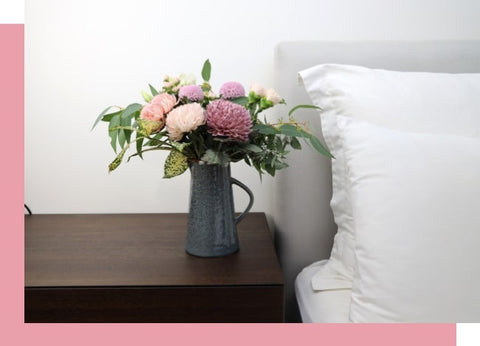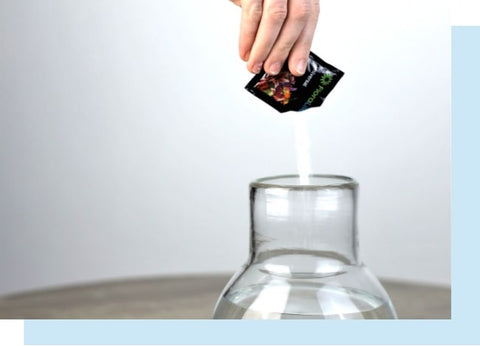Getting the most out of your flowers
We source our flowers direct from the growers and wholesalers, so you receive them fresher and faster!
However, to get the maximum enjoyment and longevity from your flowers, you will need to show them a little TLC when they arrive. They are living things after all!
Here are a few easy steps to follow that will ensure that your flowers look their absolute best, and last as long as possible.

1) Start with a clean vase & fresh water
Minimise bacteria growth. Bacteria and fungi live everywhere and will be absorbed by your flowers through the cut surface of the stem. To minimise this, it is critical to use a clean vase and fresh water. Don't stress too much though! We supply a special flower food that contains an anti-microbial element, helping to inhibit bacterial growth and keep your flowers healthy.
Use lukewarm (30°C - 40°C), clean water. Most flowers absorb warm water more efficiently than cold (the notable exception are spring bulb flowers like tulips, which do best in cold water). Tap water is usually perfectly fine as long as it doesn't contain a high percentage of dissolved minerals (hard water), which may block the flowers' ability to hydrate properly. Remember to stay away from salt water - flowers enjoy drinking salty water about as much as you do!
2) Cut Stems & Remove Leaves
Re-cut the stems at an angle. Removing at least 2 - 3 cm off the bottom of the stem. We recommend using a sharp knife rather than scissors as this will avoid crushing the stem and therefore the vascular system. The diagonal cut opens more stem area for hydration and prevents the end of the stem from resting directly on the bottom of the vase and impeding water absorption.
Remove leaves below the water line. Submerged leaves water will deteriorate and rot, spreading fungi and bacteria that damage the vascular system, preventing hydration and eventually causing your flowers to wilt and die. Take care when removing leaves, as breaks in the stem allow bacteria to enter and damage the flower. Do Not remove all leaves above the water line, as flowers require their leaves as part of the hydration process.
3) Use the Flower Food provided
As soon as a flower is cut it stops receiving vital nourishment and water. Each of our boxes comes with a sachet of flower food which has been specially developed to simulate the flower's original environment, and allows the flower to fully bloom. Using flower food can increase vase life by up to 60% compared to water alone.
A number of home recipes (everything from Aspirin to bleach) exist that supposedly extending vase life. However, we recommend using our professionally formulated flower food, as it has been scientifically developed to provide your flowers with the sustenance and protection they need. Our flower food sachets contain a special mixture of sucrose, acidifier, microorganism inhibitors and agents to protect the flowers from sediment and diluted salts.
Please follow the directions on the package and always use the recommended amount. Adding more than the recommended dose can be just as harmful as not using it at all.

4) Ongoing Care Tips
Monitor the water level daily and replace every 2-3 days. Cloudy water can be a sign that bacteria has started to grow and is attacking the stems. In this case the water should be completely exchanged for fresh water. Additionally you should re-fill vases with fresh water if water levels drop.
Re-trim your stems every 2-3 days. Flowers start to slowly die from the tips of their stems, inhibiting water uptake. By trimming an extra 1 cm off the stems ever few days, your flowers will stay healthy and live longer.
Remember: flowers don't love the heat. If possible, keep them away from direct sunlight and drafts. If it gets very hot, you may want to consider moving your flowers to the coolest part of the house or even storing them in the fridge. If you store flowers in the fridge please ensure that there are no apples present as they release a gas called ethylene, which accelerates the ageing process.
ROSES - SPECIAL CARE INSTRUCTIONS
- We send our roses with their protective outer petals still in place. This protects them during transportation. Gently remove these, exposing the delicate inner petals.
- Cut stems on an angle about 3-5 cm from the end, using a sharp knife or scissors. Do not bruise or flatten the stems by using blunt utensils. Ideally cut flowers underwater as this prevents air being drawn into the stem, creating a pocket of air or an embolism that prevents water absorption. Our flowers are sent dry and not cutting them may prevent them from being able to re-hydrate once arranged.
- Remove all leaves that sit below the water line and place in a clean vase. Leaves in contact with water can spread bacteria, shortening the vase life of your flowers.
- Use lukewarm temperature water: studies have shown that oxygen is drawn up more easily through the stems when water is lukewarm.
- Add the flower food sachet provided and remember to change the water in the vase every 2-3 days.
- Continue to remove old outer petals from the rose head to allow the rose to fully open.
TULIPS - SPECIAL INSTRUCTIONS
- We send our Tulips in bud form, which protects their delicate petals. Within a few days they will fully open to reveal their beautiful colour.
- Tulips are not a big fan of the heat, and unlike most flowers they prefer cool water. It is best to keep them in an unheated room and away from direct sunlight.
- Re-cut tulip stems on an angle every 3 days to assist with hydration.
- Tulips continue to grow once cut and, generally grow towards the light.
- Over time they will naturally bend or ‘droop’, which is normal. Wrapping them in damp newspaper and standing them in water overnight can help them stay upright - or try supporting them in your arrangement with surrounding flowers!
LILIES - SPECIAL INSTRUCTIONS
- Our lilies are sent while still in bud form, and will open gradually in well-lit areas within a few days.
- As with all flowers, re-cut stems 2-3 cm on an angle every 2-3 days. This helps them absorb water and nutrients, extending their vase life.
- We suggest cutting the pollen (anthers) from within lilies as they open, to prevent the staining of clothing, furniture and carpets. Lily pollen can stain clothing, so take care when removing the anthers. If you do get some pollen on your clothes, the best way to remove it is by dabbing the area with some sticky tape, lifting the pollen off the clothes. Attempting to rub it away will only push it deeper into the clothing fibres.
- The Pollen from lilies is also poisonous to cats, and we recommend cat owners do not purchase bouquets that contain lilies.


